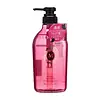What's inside
What's inside
 Key Ingredients
Key Ingredients

No key ingredients
 Benefits
Benefits

 Concerns
Concerns

 Ingredients Side-by-side
Ingredients Side-by-side

Water
Skin ConditioningCetearyl Alcohol
EmollientCetyl Alcohol
EmollientBehentrimonium Chloride
PreservativeStearalkonium Chloride
PreservativeCaprylic/Capric Triglyceride
MaskingPropanediol
SolventItaconic Acid
AntimicrobialArginine
MaskingPanthenol
Skin ConditioningLinum Usitatissimum Seed Extract
PerfumingSalvia Hispanica Seed Extract
EmollientPolyglyceryl-10 Laurate
Skin ConditioningCetrimonium Chloride
AntimicrobialBis-PCA Dimethicone
Disodium PEG-12 Dimethicone Sulfosuccinate
CleansingHydroxyethylcellulose
Emulsion StabilisingButylene Glycol
HumectantIsopropyl Alcohol
SolventParfum
MaskingHexyl Cinnamal
PerfumingAlpha-Isomethyl Ionone
PerfumingTetrasodium Glutamate Diacetate
Aminomethyl Propanol
BufferingPhenoxyethanol
PreservativeEthylhexylglycerin
Skin ConditioningWater, Cetearyl Alcohol, Cetyl Alcohol, Behentrimonium Chloride, Stearalkonium Chloride, Caprylic/Capric Triglyceride, Propanediol, Itaconic Acid, Arginine, Panthenol, Linum Usitatissimum Seed Extract, Salvia Hispanica Seed Extract, Polyglyceryl-10 Laurate, Cetrimonium Chloride, Bis-PCA Dimethicone, Disodium PEG-12 Dimethicone Sulfosuccinate, Hydroxyethylcellulose, Butylene Glycol, Isopropyl Alcohol, Parfum, Hexyl Cinnamal, Alpha-Isomethyl Ionone, Tetrasodium Glutamate Diacetate, Aminomethyl Propanol, Phenoxyethanol, Ethylhexylglycerin
Water
Skin ConditioningSodium Laureth Sulfate
CleansingCocamidopropyl Betaine
CleansingDipropylene Glycol
HumectantSodium Glycolate
BufferingGuar Hydroxypropyltrimonium Chloride
Skin ConditioningHydroxyethyl Urea
HumectantPolyquaternium-7
Propyltrimoniumchloride Acrylamide/Dimethylacrylamide Copolymer
Lactic Acid
BufferingHoney
HumectantSodium Hyaluronate
HumectantHydrolyzed Conchiolin Protein
Skin ConditioningTea-Sulfate
BufferingLauric Acid
CleansingCitric Acid
BufferingSalicylic Acid
MaskingDisodium EDTA
Ammonium Lactate
BufferingButylene Glycol
HumectantPhenoxyethanol
PreservativeBenzyl Benzoate
AntimicrobialParfum
MaskingWater, Sodium Laureth Sulfate, Cocamidopropyl Betaine, Dipropylene Glycol, Sodium Glycolate, Guar Hydroxypropyltrimonium Chloride, Hydroxyethyl Urea, Polyquaternium-7, Propyltrimoniumchloride Acrylamide/Dimethylacrylamide Copolymer, Lactic Acid, Honey, Sodium Hyaluronate, Hydrolyzed Conchiolin Protein, Tea-Sulfate, Lauric Acid, Citric Acid, Salicylic Acid, Disodium EDTA, Ammonium Lactate, Butylene Glycol, Phenoxyethanol, Benzyl Benzoate, Parfum
Ingredients Explained
These ingredients are found in both products.
Ingredients higher up in an ingredient list are typically present in a larger amount.
Butylene Glycol (or BG) is used within cosmetic products for a few different reasons:
Overall, Butylene Glycol is a safe and well-rounded ingredient that works well with other ingredients.
Though this ingredient works well with most skin types, some people with sensitive skin may experience a reaction such as allergic rashes, closed comedones, or itchiness.
Learn more about Butylene GlycolParfum is a catch-all term for an ingredient or more that is used to give a scent to products.
Also called "fragrance", this ingredient can be a blend of hundreds of chemicals or plant oils. This means every product with "fragrance" or "parfum" in the ingredients list is a different mixture.
For instance, Habanolide is a proprietary trade name for a specific aroma chemical. When used as a fragrance ingredient in cosmetics, most aroma chemicals fall under the broad labeling category of “FRAGRANCE” or “PARFUM” according to EU and US regulations.
The term 'parfum' or 'fragrance' is not regulated in many countries. In many cases, it is up to the brand to define this term.
For instance, many brands choose to label themselves as "fragrance-free" because they are not using synthetic fragrances. However, their products may still contain ingredients such as essential oils that are considered a fragrance by INCI standards.
One example is Calendula flower extract. Calendula is an essential oil that still imparts a scent or 'fragrance'.
Depending on the blend, the ingredients in the mixture can cause allergies and sensitivities on the skin. Some ingredients that are known EU allergens include linalool and citronellol.
Parfum can also be used to mask or cover an unpleasant scent.
The bottom line is: not all fragrances/parfum/ingredients are created equally. If you are worried about fragrances, we recommend taking a closer look at an ingredient. And of course, we always recommend speaking with a professional.
Learn more about ParfumPhenoxyethanol is a preservative that has germicide, antimicrobial, and aromatic properties. Studies show that phenoxyethanol can prevent microbial growth. By itself, it has a scent that is similar to that of a rose.
It's often used in formulations along with Caprylyl Glycol to preserve the shelf life of products.
Water. It's the most common cosmetic ingredient of all. You'll usually see it at the top of ingredient lists, meaning that it makes up the largest part of the product.
So why is it so popular? Water most often acts as a solvent - this means that it helps dissolve other ingredients into the formulation.
You'll also recognize water as that liquid we all need to stay alive. If you see this, drink a glass of water. Stay hydrated!
Learn more about Water